The Line of Bottom
Monday 30th May 2016. I enjoy the new BBC film of A Midsummer Night’s Dream, as adapted by Russell T Davies. Maxine Peake is Titania, Matt Lucas is Bottom. Both are perfectly cast. Ms Peake already has that angular face one finds in Victorian paintings of fairies, while Mr Lucas brings cuddliness to the pompous Bottom even before he acquires the ass’s head (and then he really is cuddly, like a giant soft toy).Â
It’s made with the same team as Mr Davies’s Doctor Who productions, the ones with Christopher Eccleston and David Tennant. I’d say it’s especially like the Davies mini-series just before that: the David Tennant Casanova. It’s that same feeling of a fizzy, dressed-up world operating on a line of tension, with a progressive approach at one end – deliberate anachronisms, multi-ethnic casting, gay characters – and an embracing of popular entertainment at the other. This latest take on Shakespeare went out at 8.30pm on BBC1, so it had to appeal to as many people as possible. Yet it still had Davies’s personal vision at its heart: a world where fascist flags are ripped up into party decorations, where love comes in all shapes and sizes, and everyone dances to Bernard Cribbins singing ‘It Was A Lover And His Lass’. Can’t argue with that.
For all the liberties taken with the story – such as Theseus as a fascist dictator with an iPad – it’s difficult to say it’s any more radical than an average modern stage production. Since I visited the British Library’s Shakespeare exhibition, I’ve been reading about the Peter Brook 1970 RSC Dream, with its minimalist white squash court, stilts and trapezes. Birkbeck Library has two books about that production alone: a detailed making-of account by David Selbourne, and an RSC script with all the stage directions, where one can study Brook’s decisions line-by-line. His Bottom, for instance, merely gains a red nose when transformed by Puck. If a modern production has Bottom with ass’s ears, as in the BBC one, it’s still more traditional than Brook.
In the press there was a slight fuss about the BBC Titania kissing Hippolyta. This is nothing new. I read that the current Globe production of Midsummer Night’s Dream has Helena as a gay man called Helenus, with Demetrius as his lover in denial. The Globe’s previous Dream three years ago had Puck and Oberon passionately kissing. That particular Puck was played by Matthew Tennyson, a very pretty young man who happens to be a descendent of the Tennyson. He now pops up in the BBC film as Lysander, with a pair of glasses that rather makes him resemble Harry Potter. I read that as a deliberate nod to the way Shakespeare has direct links to popular culture now. If it uses the English language, it’s connected to Shakespeare.
I’ve also just remembered that there’s a lesbian bar on the Charing Cross Road, called Titania.
***
I’m going through my untidy piles of old papers, with a rule of throwing out five things every day. Discarding the ephemeral is easier when you realise it gives more value to the things you keep. And yet I do like the physical evidence of a life; the proof that whatever I’ve done, I’ve lived.
Today, with my head full of thoughts of A Midsummer’s Night’s Dream, I find a couple of letters from Dad that reference that very play.
They’re written on the backs of his own photocopied cartoons. One has a tiny Puck flying around the shoulders of two American comic book superheroes. Or rather, two versions of the same superhero, The Flash. One is the 1940s Golden Age Flash, with the winged hat; the other is the later Silver Age incarnation, with the one-piece costume and the mask.
Puck is saying: ‘I will put a girdle around the Earth in forty minutes‘. The two Flashes reply, ‘Been there, done that!’
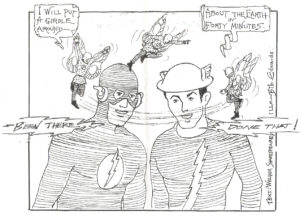
Dad’s other cartoon has a tiny Titania offering a rose to Mr Spock from Star Trek. Says Titania: ‘Come sit thee down upon this flowery bed / While I thy amiable cheeks do coy / And stick musk roses in thy sleek, smooth head / And kiss thy fair large ears, my gentle joy.’
Mr Spock, who of course has ‘fair large ears’, replies, ‘Fascinating!’.
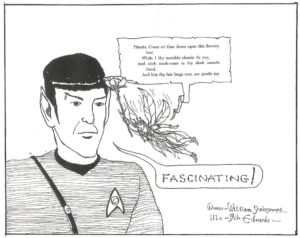
***
Friday 3rd June 2016. I find a Dutch newspaper supplement from late 2007, where I’m the cover star. Well, that’s if the cover of a supplement counts as a cover. It’s for an article on Modern Dandies of London (I think). Me alongside Sebastian Horsley, with his two fingers up to the camera. I still live in the same room, albeit with different curtains.
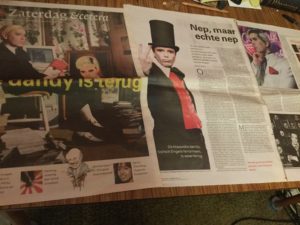
***
More mopping-up of unpublished activity.
Friday 6th May: While people have stopped me in the street to ask me why I hadn’t written more about the death of Prince, no one has yet chided me for my complete omission of the London mayoral election. Perhaps that sums up what sort of diarist I am.
Still, it needs to be said that I did indeed vote. Voters had a second preference, so I gave my first choice to the Greens’ Sian Berry, and my second to Labour’s Sadiq Khan. Khan triumphed, his victory announced late into the night of the 6th (after an agonising delay of many hours). Ms Berry came in at an impressive third, after the Conservatives’ Zac Goldsmith. She also took up a seat on the London Assembly, thanks to the Greens doing well enough on the ‘London-wide’ polling sheets.
It’s the first election result in years where I’ve felt optimistic about the future.
***
Films seen recently:
Tuesday 17th May 2016: Green Room at the ICA. £3. A horror thriller with the unusual backdrop of a right-wing skinhead music scene, in contemporary rural Oregon. Rather different to the Portland liberals of that same state, as spoofed in Portlandia. But then I suppose it’s analogous to the way parts of Sussex can be rather less progressive than Brighton.
Imogen Poots’s character has one of those skinhead-scene girls’ haircuts that flatter while adding a certain toughness: long at the sides with a sharp fringe at the front (a Chelsea Fringe? a Feathercut? not sure). The boots and braces look for the men is well-researched too – straight out of 1970s Britain, but jostling here alongside iPhones and American accents. Much significance given to the colour of laces in DMs. A couple of the scenes are extremely gory. But then it is meant to be a horror film too. I suppose boxes must be ticked in plot, in the same way that the characters must tick boxes with their clothes, their taste in rock music, and with their beliefs. These days, I find discussions about belonging thrilling enough; blood and violence less so.
Friday 20th May 2016: Heart of a Dog at the ICA. £3. Laurie Anderson’s stunning film essay, ostensibly about the death of her rat terrier Lolabelle, but touching on life and death in all kinds of ways, from the passing of friends and relatives, to the changes in New York after 9/11. Her husband Lou Reed’s death (which happened during the making of the film) isn’t explicitly referred to, but he’s there briefly as an actor (playing a doctor), and as himself (in footage of the couple on a beach). He also provides the closing song, and in the very last shot he is seen holding the dog.
At one point Anderson talks about that unhappy experience that most pet owners must endure: going to the vet to hear what she calls ‘The Speech’. The one that asks the owner if the pet can be put to sleep. It reminded me how I was recently told, separately, of the deaths of two cats I used to look after in North London: Claudia Andrei’s cat Sevig, and Jenn Connor’s Vyvian. When Sevig became very frail, Claudia pushed him around the streets of Edinburgh in a shopping trolley – ‘the Sevig-mobile’. After seeing Heart of a Dog I realised how lucky I was to have the pleasure of living with these beautiful creatures, without ever having to face The Speech.
Tuesday 24th May 2016: Troublemakers: The Story of Land Art, ICA. £3. A documentary on a group of artists in the late 60s and early 70s, who turned vast, desolate parts of the US into their own canvasses in the pure pursuit of Making Art. I was familiar with the Lightning Field artwork – all those lightning rods against the sky- but I hadn’t heard about works like Double Negative, where two gigantic rectangular chunks were carved out of a rocky mesa. According to the credits, some of the works begun in the 1970s are still in progress today.
Thursday 26th May 2016: Love and Friendship at the BFI. Free, courtesy of Tim Chipping, a fellow Whit Stillman fan (we went to see Barcelona together on its 1990s release). The film is followed by a Q&A with Whit Stillman, who is in typically eloquent and wry form. The film adapts Jane Austen’s Lady Susan, though there are touches of Wilde in Stillman’s script too. It’s verbose without ever being dry, and in terms of quips and jokes, it’s funnier than most modern comedies. My favourite film this year.
Friday 3rd June 2016: The Witch at the Prince Charles. £4. A tale of supernatural goings-on amongst a family of Puritan settlers, in seventeenth-century New England. Like Green Room, it blends the horror genre with more unusual aspects, in this case, gritty historical drama. The dialogue is lifted straight from the literature of the time: all ‘thy’s and ‘thee’s. As with Whit Stillman, the style only works once you realise what the director is trying to do: in this case, make a film that takes folk legends as real without question. It’s as if the film was made by seventeenth-century Puritans, as well as being about them.
***
A useful acronym from Atalanta K, who lost her bag after a night of carousing: ‘I had a CRAFT moment. As in: Can’t Remember A F-ing Thing.’
Tags:
a midsummer's night dream,
bbc,
Claudia Andrei,
dad,
dandies,
Dandyism,
films,
green room,
heart of a dog,
ICA,
jenn connor,
laurie anderson,
love and friendship,
Prince charles cinema,
Sebastian Horsley,
sevig,
shakespeare,
the witch,
vyvian,
whit stillman
Route 66
Saturday 5th September 2015.
Viktor Wynd hires me to give a couple of guided tours in his Museum of Curiosities, in Mare St. The museum is so packed with objects that I have to be selective with what I talk about. As it is, I feel more confident in focussing on its ‘Dandy Corner’, my specialist subject. It has a handful of exhibits on the unholy trinity of Sebastian Horsley, Stephen Tennant and Quentin Crisp. I do the tours wearing SH’s silver suit, as a bonus for the visitors. Though perhaps I overestimate their interest in the history of dandyism. When I ask for questions, I get: ‘Where’s the shrunken heads?’
I’m given free cocktails by the museum bar. My favourite is a ‘Gone With The Wynd’ – absinthe, Chambord, raspberries, egg white. The late Mr H also has a cocktail, the ‘Sebastian Speedball’ – bourbon, pineapple and lime juice. There’s postcards for sale of SH during his crucifixion, plus one of a painting by Leonora Carrington. Tessa Farmer’s ‘evil fairy’ sculptures leave me in awe, such is their miniature intricacy. And humour, too, in the way they interact with the other exhibits. Two of her skeletal fairies hover around the Horsley suit, unleashing a vial of clothes moths.
* * *
Monday 7th September 2015.
Heather M is a volunteer at the V&A. Today she takes me as her guest on an in-house tour of Blythe House, near the Olympia centre in Kensington. This is the museum’s archive and storage depot for its theatre and performance collection. The building is an endless Victorian warren of towering, tottering shelves, costumes on rails, bookcases, and the largest amount of filing boxes I’ve seen in one room. What springs to mind is the last scene of Raiders of the Lost Ark. When the tour stops, I randomly lean out at a shelf and pick up a box to see what it contains. The correspondence of Paul Schofield.
In the archive reading room are two of the cardboard cut-outs used in the photoshoot for Peter Blake’s Sgt Pepper sleeve. Oscar Wilde and Edgar Allen Poe. I touch the Wilde cut-out, and feel almost giddy with history.
* * *
Tuesday 8th September 2015.
With Shanthi S to see Ricki and the Flash, where Meryl Streep plays an aging rock singer. The plot – about her reconciliation with estranged relatives – is very slight, but it all comes together pleasingly enough. A touch of Richard Curtis idealism in the finale. The film’s real highlights are its concert scenes, along with its refreshing depiction of an equally-matched older couple, who clearly have a youthful sexual chemistry – the energetic Streep with the boyish Rick Springfield. Both are 66. The same age as Jeremy Corbyn.
* * *
Thursday 10th September 2015.
I enjoy the Buzzfeed website, even though it’s clearly targeted at people younger than me. Today I idly start doing a quiz that is meant to guess your age. ‘Pick the phone you most loved as a kid’. It occurs to me that I have never once felt love for a phone.
* * *
I read Taylor Parkes’s article on attending a Jeremy Corbyn event, for The Quietus. He notes that the average age of the Corbyn fans is ‘probably fifty, but there are almost no fifty-year-olds. Mostly, it’s the under-30s and the over-60s.’ I wonder if this is because many of those aged between 30 and 60 tend to channel their political energies onto the internet, shouting with their fingers on discussion threads. Whenever I make the mistake of glancing at the comments under an article, I am amazed that so many people spend so much of their lives hammering out so many unasked-for words. And to what end?
A great number of internet comments can be paraphrased as the same comment: ‘I am lonely’.
* * *
Friday 11th September 2015.
Evening: to Vout-O-Reenee’s in Tower Hill for the launch of Liggers & Dreamers. It’s a new novella by Josie Demuth, published by Thin Man Press. The book is an entertaining depiction of a group of people who constantly gate-crash swanky parties and private views. The actress Jenny Runacre reads an extract, and later there’s a set of stunning, Bowie-esque piano songs by Bryn Phillips (who really should be putting records out). I chat to Debbie Smith and Mikey Georgeson (he of David Devant).
Manage to read the novella during the day. Some of the ruses of Ms Demuth’s characters remind me of my own attempts to get into rock aftershows in the past. Particularly the one where a single spare stick-on backstage pass can be carried back out by a second person, and used to get a group of people past a bouncer one-by-one, with much surreptitious unsticking and re-sticking going on. I suspect the rise of wristbands has made this less common.
Ms Demith’s novella also makes some thoughtful points, amid lots of broad satire, in-jokes and slapstick. One is that a party freeloader might think of themselves self-righteously, as if redressing the unfairness of the world. They might view their efforts as tantamount to being a canape-scoffing Robin Hood, however misguidedly (I thought of the woman caught on camera during the 2011 London riots, who said she was looting a small chemist’s ‘to get our taxes back’). Another is that some freeloaders might add to the atmosphere of an event, and so they ‘pay’ their way in that sense. There’s a scene where a gallery has managed to ban freeloaders so effectively that the only people at their openings are those who can afford to buy the paintings, ie wealthy bankers. As a result the events become uniform, perfunctory, and dull, and so the ban is soon lifted. For me, this is an optimistic take on what might happen with the current pricing-out of Londoners as a whole.
Though not just yet. The local newspaper regularly covers long-running independent shops which are having to close down, due to escalations in rent. This week it’s the second-hand bookshop Ripping Yarns in Archway Road, owned by Celia Mitchell since the 1970s (when it was named after the Michael Palin and Terry Jones TV series). ‘It’s like a death in the family,’ Ms Mitchell says in the paper. She’s talking about her own life, but the phrase applies to Highgate too.
Tags:
blindness,
bryn phillips,
debbie smith,
jenny runacre,
jeremy corbyn again,
josie demuth,
liggers & dreamers,
mikey georgeson,
ricki and the flash,
ripping yarns bookshop,
Sebastian Horsley,
thin man press,
viktor wynd,
vout-o-reenee's
Cufflinks: Piercings For the Squeamish
Saturday 20th June 2015.
To the Little Baobab Bar in Lower Clapton Road, for fellow student Hester R’s birthday. It’s one of those times where I seem to only know the birthday person, and not any of their friends. But this time I surprise myself and chat happily away to whomever I’m with. I wonder if one reason for this is that no one has been to the venue before, so there’s an extra need to speak to each other and overcome the unfamiliarity. Â The bar is Senegalese and West African, and despite the usual décor of exposed brickwork and dangling light fittings that one finds in East London eateries, it doesn’t feel overly trendy. The mojitos are made with baobab juice: delicious and cheap (and so even easier to enjoy). Later on, a couple of musicians play in one corner: one on acoustic guitar, and one on a tall, harp-like stringed instrument. The music, presumably Senegalese, turns out to be classical, slow and soothing, almost ambient.
* * *
On the tube. A group of young people all get on at once, decked out in matching red tracksuits, green baseball caps, and big plastic sunglasses. They huddle in the aisle and reel off a series of chants together, cheerleader-style. At first I wonder if they’re part of a spontaneous people-power event, like a flash mob, or a wry protest, or an immersive film night. Eventually one of them comes over to me and hands me a card, now more subdued and sheepish as he does so. It’s for a company that provides home deliveries from shops.
This is a common London feeling: the realisation that something intriguing and unusual is just another advert.
* * *
Irritations over modern language. A common subject line on emails is ‘in case you missed it’, sometimes abbreviated to ICYMI. It’s the neediness of the phrase that irks me, as well as the way it bevels down individuality to join in with a consensus of limited catchphrases. Another is ‘a thing’, as in ‘I did a thing’ or ‘it’s for a thing’ or ‘is X a thing now’?
Perhaps one reason for my resentment of such phrases is the same as the one for my resentment over the ubiquity of beards: I don’t think I am capable of joining in. So it becomes another way of feeling that modern life is something other people do, not me.
In any case, the idea of ‘in case you missed it’ has a threatening quality, to my mind. It’s like another cliché that journalists like, when talking about something that’s reached saturation level in the media: ‘Unless you’ve been living in a cave for the last month…’ The only sane response to this phrase is to become a cave-dweller at once.
In the news this week, the slang acronym FOMO – Fear Of Missing Out – is added to the Oxford English Dictionary. ‘Romo’ has yet to be included, twenty years on after its coinage in the UK music media, and its association with my band, Orlando. Given that all life is missing out, one way or another, I like to think that Romo has acquired a new meaning as an acronym. ROMO: Relief Of Missing Out.
* * *
I amuse myself watching a late night music documentary about Prince, spoofing it in my head with lines like ‘In 1985, Prince was accused of unabashed naughtiness… In 1986, Prince invented a new note, X, which he only ever played for extra naughtiness.’ And to the tune ‘When Doves Cry’, I find myself thinking of our new Lord Chancellor, and sing the phrase ‘When Goves Cry’.
* * *
Sunday 21st June 2015.
More thoughts of in-jokery, this time for humanities students who are also fans of Mean Girls: ‘Stop trying to make Orientalism happen, Edward. It’s not going to happen.’
On the internet, where context is the first casualty, there is now the added entertainment of watching other people not get the joke. On Twitter, there’s an account that purely caters to this curious mix of schadenfreude and scorn, @YesThatsTheJoke. But presumably it only works for the jokes that the YesThatsTheJoke person gets, too.
On The Quietus site this week, there’s a review of the new Muse album by ‘Mr Agreeable’. Mr Agreeable is a jokey fictional avatar created in a pre-web age. He first appeared in the early 90s (possibly earlier), as a regular feature in Melody Maker. The joke is that Mr Agreeable is anything but agreeable. He not so much writes as spews out a torrent of asterisk-spattered swear words, disproportionate vitriol, and downright violent imagery. His over-the-top-ness is, as they say, the joke. For aging readers of Melody Maker like me, seeing new Mr Agreeable reviews now is a nostalgic pleasure. But this being the internet, there is a comments section underneath. And in that section are lots of angry young Muse fans complaining that the review is not proper journalism. Yes, one wants to say, with deadpan resignation. Yes, that’s the joke.
How to explain to them that there was once a magazine – sorry, a ‘thing’ – called Melody Maker? More to the point, how to explain that once upon a time, columns of pure hatred were clearly meant to be read as jokes? I now realise that Mr Agreeable was a prophet of the Web. Disproportionate anger is what people do constantly now, sometimes professionally (Katie Hopkins, Jeremy Clarkson). Except that they’re not joking.
* * *
Wednesday 24th June 2015.
Put off by one job advert today, purely by its usage of exclamation marks.
Most days this week, I am wearing a white suit with seahorse cufflinks. I like to think of cufflinks as the squeamish person’s piercings.
I binge-watch the new (third) series of Orange Is The New Black. The phrase is apt, as I feel a little ill and bloated afterwards. The series is superb, though, finding new backstories for even the minor characters. There’s about thirty recurring roles, so if a plotline isn’t interesting, a better one always comes along soon enough. What I’d like to see now is Carol Morley writing and directing an episode. She’d be perfect.
* * *
Thursday 25th June 2015.
I meet Mum at St Pancras, and we have lunch at the British Library, to celebrate her birthday. The library café area finally has plenty of free seats, and in the afternoon too. All the students seem to have either taken their laptops outside into the nice weather (more chairs and tables there), or – more likely – they’ve finished their studies. Where are they all now, I wonder?
Glastonbury must be one answer. I try to balance my envy of those going to or appearing at festivals, with the consolatory thought that I also love sleeping in a room with four walls. Not to mention my love of indoor flushing toilets. As it is, going to Glastonbury purely as a punter seems increasingly redundant. These days, with the blanket media coverage, it comes to you.
Mum and I take a look at the current free exhibition in the British Library foyer. It’s one big exhibit: Cornelia Parker’s Magna Carta (An Embroidery). Marking the anniversary of the real thing – which is on show next door – this Magna Carta is a stitched version of the Wikipedia page about the Magna Carta, as it appeared on the day of the 799th anniversary, last year. Most of the text has been stitched by people in the Fine Cell Work charity, which trains convicted prisoners in needlework skills. Mum is thrilled about this: she went to a FCW talk a few months ago – given by a former convict – and found his story of finding new purpose through the art of stitching utterly fascinating. A few of the words have been stitched by public figures, such as Jarvis Cocker, whose selected words are, rather wonderfully, ‘Common People’. Somehow they got Edward Snowdon to stitch a word, too, and it’s one which sums up the essence of the project: ‘liberty’.
* * *
In a lonely mood, I overreact when I realise that I’ve been blocked by a music writer on Twitter. A second one, in fact. I have no idea why. I don’t think I’ve ever had any kind of interaction with the writer – I just want to read his work. I ask around on Twitter and find someone who assures me that blocking is what that particular writer likes to do, apparently notoriously, and often of people he either doesn’t like, or doesn’t like by association. I also find another writer who happily blocks people he doesn’t like pre-emptively, because he hates the idea of them reading his work.
So much for Forster’s ‘only connect’. I have a vision of books in a library snapping shut as a reader approaches: ‘Oh no, not you!’
I come away from this thinking that (a) I’m not as unreasonably grumpy as I think I am, not compared to others, (b) I would never block someone on Twitter unless they’d actively sent me abuse, and (c) I do hope Virginia Woolf doesn’t think I’m a twat.
* * *
Friday 26th June 2015.
I watch the third and final episode of How to be a Bohemian with Victoria Coren Mitchell. There’s a brief glimpse of one of Maggi Hambling’s paintings of Sebastian Horsley, which Ms Coren Mitchell narrates as ‘portraits of other bohemians…’
For me, this is particularly interesting. Mr H once told me how Ms M had cancelled an interview she’d intended to have with him, due to his using one of his typically provocative comments. As she said herself in her column (2 September 2007):
I rang him to suggest meeting in Belsize Park, a leafy area of north London.
‘I can’t bear Belsize Park,’ yawned Horsley. ‘It’s full of Jews.’
I have a vivid memory of actually telling Mr H off about this, as I couldn’t agree with this particular manner of épater la bourgeoisie. ‘Why do you say things you don’t really mean?’  I said. ‘Oh well…’ was his reply.
On another occasion, when Mr Horsley was reading from his autobiography and got to some general statement about sex and women, a lady in the audience shouted out ‘You chauvinist swine!’ (or words to that effect), and stormed out. Sebastian smiled sweetly after her. ‘I’ll say the reverse if it makes you come back!’
So I now wonder if Ms Coren Mitchell has forgiven Mr Horsley, by including him in her film, albeit very briefly. Or if she accepted him as a modern bohemian, in spite of her reservations, as she did for the Bloomsbury Group. Either way, it was good to see him included.
One fictional bohemian that I’m surprised wasn’t mentioned at all is Sherlock Holmes. The story that made him famous was the first of the Doyle tales which appeared in The Strand, ‘A Scandal In Bohemia’. Much of the story plays on the pun of his client being the blackmailed King of Bohemia, while Holmes is scandalised as a bohemian in terms of his bachelor lifestyle. He falls for a woman who defeats him: Irene Adler. Even the Benedict Cumberbatch Sherlock makes much of the main character’s bohemianism. The word might not be mentioned, but his bachelor status and sense of being an odd child-like man, among conventional adults, is certainly focused upon in the series.
* * *
And that particular bohemian lives on even more. To the Phoenix cinema for Mr Holmes. Ian McKellen plays an elderly take on the Victorian detective,  set in 1947. The conceit is that in this world, Doyle’s stories exist, but they are written by Watson as pieces of popular journalism. The story switches between a 60-year-old Holmes in Baker Street, with the circumstances surrounding his last case, and a 90-something Holmes in his Sussex cottage, teaching beekeeping to a small boy, while battling against memory loss. McKellen’s performance is worth seeing alone, but there’s also lots of standard Holmes deduction scenes, tied in with poignant hints of a denied emotional life. The price of bachelorhood.
* * *
I’ve had a week of feeling very ghost-like and detached from the world. Not quite knowing which path to take next. In fact, walking around in a white suit rather makes me resemble a ghost too.
However, today I have a nice surprise. At Foyles, the staffer on the till suddenly gives me £6 off the book I’m buying, by using his staff discount.
‘Because I like your records’.
* * *
Tags:
birkbeck,
bohemians,
British Library,
getting recognised,
mr holmes,
mum,
orange is the new black,
Sebastian Horsley,
sherlock holmes,
twitter,
victoria coren mitchell
Story of The Hair
Saturday 9th May 2015.
A laid-back week of reading in cafes, or tidying up at home. ‘Cut thistles in May / They’ll grow in a day’, goes the gardening rhyme. No gardener I, not even of pot plants. Instead I prune my books, lest they march across the floor.
Lots of taking back of library books, and donating to charity shops. A certain elation now, over being able to read what I want, without the guilt of thinking I should be spending such time on a set text. But there’s also a kind of grieving, of not being able to comprehend how the course is finally over.
* * *
Monday 11th May 2015.
4pm: To Maison Bertaux in Soho for tea with Laurence Hughes. New paintings by Noel Fielding on the walls. Laurence reminds me how Derek Jarman was a regular here: he visited Jarman in his Charing Cross flat.
I rather like how this chat turns out to be my first social occasion after the election, given that LH is a UKIP member, and I’m a Green. We politely agree to disagree over matters political, but otherwise get on fine. As it is, we can grumble in unison over the unfairness of the voting system, when millions of votes can only result in a single MP.
Today I remind myself how many of my favourite writers were not exactly tuned into my political wavelength. Evelyn Waugh for starters. A man who in his novels could write so perceptively and beautifully about the business of being human full stop, while in his diary he made remarks like: ‘It is impudent and exorbitant to demand truth from the lower classes’ (Waugh: Diaries, July 1961, p. 784).
Similarly, I’ll always remember how during my candidacy in the 2006 Haringey Council elections, the people who were friendliest to me at the count, after the Greens, were the local Tories. All anyone ever wants to know about anyone is ‘were they nice?‘
* * *
Wednesday 13th May 2015.
A day trip to Brighton. £19 day return, a noon train from Victoria, the sea appearing in under an hour. I feel smug about the timing: the sunniest day all week. Some men on the pier are going bare-chested, in that time-honoured, overly optimistic, utterly English way. I revisit the Pavilion for tea on the balcony, this time learning from the staff that the Banqueting Hall was once used for a film dream sequence. It’s in the Barbra Streisand musical, On A Clear Day You Can See Forever (1970). I find it on YouTube (one must search for the song ‘Love With All The Trimmings’). Given that the Pavilion is often held up as an example of camp avant la lettre, and that the building inspired Aubrey Beardsley, who in turn inspired a whole universe of camp, it’s fair to say that the Streisand scene attains a level of campness that soars off the scale. Even more so: her costume is designed by Cecil Beaton.
* * *
Thursday 14th May 2015.
To the new Maggi Hambling exhibition at Somerset House: War Requiem & Aftermath. A couple of sound installations, one using Britten’s War Requiem, one using ambient sea noises. Most of it is on the theme of war and ruins, but there’s also a posthumous portrait of Sebastian Horsley, which I’d not seen before. SH’s face is a mass of morbid, octopoid black swirls, in the typical Hambling style. Actually, my hair is very Hambling-esque at the moment. I’ve left cutting it for so long that it’s turned into a thick hedge of curved lines, without quite becoming curly. It never grows down, only out.
* * *
Friday 15th May 2015.
The Boston bomber gets the death sentence. He is 21.
For all its faults, today I feel glad to live in a country that has fully abolished capital punishment, in all circumstances.
* * *
To the Curzon Bloomsbury cinema in the Brunswick Centre, formerly the Renoir. A sign in the shopping centre nearby still points to it as the Renoir. This triggers a phobia of mine: signs that point to things that no longer exist. A hint of reality breaking down. Bloomsbury has a shaky relationship with time as it is: every other building is entirely held together by blue plaques.
In music news this week: Jarvis Cocker and the other members of Pulp unveil a plaque to mark the site of their first gig. Cocker gives a witty reply to the inevitable query as to the next Pulp reunion: ‘I think plaques are the way forward for Pulp now.’ The heritage explosion certainly mirrors the endless need for commenting online: primary content must be secured, anchored, celebrated, pored over. No end of anniversaries.
And so: no end of documentaries either. I’m here to investigate the new Bertha DocHouse inside the Curzon Bloomsbury, billed as London’s first documentary-only cinema. It’s one of several small screens inside the same underground complex, so I’m not sure it counts as a ‘cinema’ in itself. However, the screen is given its own little entrance lounge, Minotaur-like, deep within the labyrinth of the Curzon. This is two floors down, past three bars, and along several corridors, all of which are refurbished in a kind of Brutalist Deco style: part 1960s (to acknowledge the Brunswick Centre), and part 1920s Metropolis, with dark spaces punctuated by elegantly shaped pools of light, Â with signs in Deco lettering.
The new documentary I see on the DocHouse screen is Lambert and Stamp. It’s about Kit Lambert and Chris Stamp, who managed The Who during the band’s 1960s and early 70s heyday. In the archive footage, Chris Stamp is a shockingly pretty young man – a proper ‘Ace Face’ Mod, with an immaculate feathercut hairdo and a range of sharp suits. Much is made of the way he looked more like a rock star than the band he managed. When Terence Stamp turns out to be his brother, it all makes sense. The Epstein-esque Lambert – very gay and posh – is long dead, so Stamp – very straight and working class – does most of the talking in the film. He seems to have had a life of falling into things accidentally. He thought he’d be a documentary filmmaker himself – The Who were originally taken on in order to appear in some sort of film about the London music scene. But the band took over, and the film was never made. By the time a film was made – Tommy – Pete Townsend feared the managers had enough control, so it went to Ken Russell. Eventually it all ends in drug addiction, and the band sue Stamp and Lambert for mismanagement, though Stamp is at pains to point out that the Who owned Shepperton Studios thanks to them, so they can’t have been that bad. I later discover that Chris Stamp died in 2012. It’s proof that these independent documentaries can really take a while to come out.
Also learned: when the High Numbers changed their name to The Who (‘the High Numbers sounded too… Bingo‘), one name they considered was The Hair.
* * *
Evening: to the Birkbeck student union bar, for a drinks gathering among my fellow English BA finalists. The bar is on the fourth floor of the main college building, in Torrington Square. We stand outside, on the bar’s rooftop terrace.
Some years ago, when the smoking ban came in, the idea of there being non-smoking areas outdoors was laughed at. Not anymore. Despite being in the open air, and high above street level, half the rooftop terrace is designated for non-smoking, while the other half is for smoking. A security guard gets into a loud and embarrassing argument with one of our party. It turns out that our friend has accidentally dared to smoke slightly over the border between these two sections of unfettered breeze. It’s only now that we learn that an object, mounted on a nearby wall, is meant to mark the dividing line: ‘You’re standing on the wrong side of the satellite dish!’
* * *
Tags:
aubrey beardsley,
birkbeck,
brighton,
brighton pavilion,
lambert and stamp,
maggi hambling,
Sebastian Horsley,
the who
Reanimate Your Darlings
Saturday 22nd November 2014. I finish the first draft on the Waugh essay. Nearly a thousand words over the 1,500 word limit. It doesn’t seem like a lot, but academic writing is so painstaking. Every paragraph has to be crafted to fit a template. It has to introduce a new point, followed by an explanation of the new point, then offer up evidence in quotations. And then you have to add a little arm-wrestling with a critic on the same point, to prove you can not only look all this stuff up but that you’ve managed to think for yourself as well (something which only comes with practice).
Then there are the citations in the footnotes, which all have to be tailored to fit a particular style guide. Birkbeck’s English programme uses the one issued by MHRA. Which may sound like an unpleasant virus but is actually a little book of infallible commandments, along the lines of ‘Thou Shalt Use Full Stops In Footnotes, But Not In Bibliographies. Do Not Ask Why.’
And on top of all that, you have to abide by a word count. Which – and this is truly the bane of the student – has to include the footnotes. It’s bad enough when academic articles have long titles, but then you also have to cite the book the article is collected in, which often has a long title itself. And then you have name the book’s editors, who are often at least three people who insist on having three-word names. So the footnotes can really eat away at a word count. I always feel like Alice in the White Rabbit’s house, banging my pretty yet oversized head against the ceiling.
But then I’m bad at conciseness per se, whether it’s haikus at school or tweets today. I can’t feel at home if there’s not enough room to swing a clause.
* * *
Evening: to the BFI Southbank. I still dislike the inelegant name and think of the venue as the old NFT. But these are branded times and one must be brave. Anyway, whatever the BFI Snickers wants to call itself, I am grateful that tonight it is showing the cult 80s film Liquid Sky. I am also grateful that Ms Silke noticed it was on, remembered that it was one of my favourite films, and invited me to see it on the big screen for the first time.
I first saw Liquid Sky on VHS, in the year 1999. A copy fell into my hands when I was in a rehearsal studio in one of the less sequinned parts of Outer London. It was the sort of area that is not so much a district as a punctuation mark. Like a lot of rehearsal studios, it existed purely to stop industrial estates from being seen together in public.
This was during my role as quondam guitarist for the band Spearmint. At one particular rehearsal the singer Mr Lee gave me the video in question. I think it may have been a gift to him, or perhaps it was an impulse buy on his own part. Either way, after seeing Liquid Sky he passed the video onto me for good, with the words ‘I think this is more your sort of thing than mine’.
He was quite right. Liquid Sky is a low-budget tale of dayglo-attired and androgynous New Romantics, who spend their days taking drugs, dressing up, performing experimental poetry, and generally draping themselves around New York until the time of the next photo shoot. As is so often the case, a flying saucer arrives full of invisible aliens who feed on sexual energy. In one scene, the heroine has sex with a male model, who in turn is played by the same actress in male drag. All this occurs to a soundtrack which resembles a synthesizer being attacked by an embittered squirrel. So yes, it is very much My Sort Of Thing.
Thankfully for the BFI, it is other people’s thing as well. This screening is healthily attended: about two-thirds full. Watching it now, I note how it nearly crosses the line from trashiness into plain bad cinema in terms of  acting and production values. Yet with its startling costumes and make-up, and with its sense of not wanting to be anything but itself, it triumphs.
* * *
Afterwards Silke and I walk around the temporary Christmas Market on the South Bank. There is a miniature railway running along the riverside. Not only miniature in height, either: it barely runs a few hundred yards. I imagine it appeals to the sort of children who find vaguely moving about to be enough excitement for one day.
We buy mulled wine from a tasteful stall outside the RFH. £3.80 for a generous mug. All the really popular stalls in the market are for food: Polish sausages, fries, Dutch pancakes, pizza slices. Silke points out a stall that only sells wooden neckties. She says it’s there every year, yet she’s never seen anyone buy a tie.
* * *
Sunday 23rd November 2014. I hack away at the essay, and get it down to the required word count. I find the process less painful if I paste the deleted words into a separate Word file marked ‘Offcuts’.
* * *.
Monday 24th November 2014. Third draft of the essay. The hacking gives way to moulding and shaping. I restore one of the deleted sections from the ‘Offcuts’ file. Some other poor passage of text takes its place instead. I walk away from its pleadings. ‘You lied to me! You said I was special!’
Never mind the writing advice about ‘kill your darlings’. It’s not enough. Kill, then reanimate your darlings. Then kill other darlings to make room. It’s a bloodbath, frankly, whatever happens.
* * *
Tuesday 25th November 2014. Fourth and fifth drafts of the essay. The moulding and shaping becomes tweezing and polishing. I think it’s okay. I upload it to the college’s website, then print out a paper version and drop it into the designated essay-scoffing letterbox in Gordon Square. That’s my deadlines for the Autumn all done. From now till January, it’s all about planning, research and reading.
Class tonight: Their Eyes Were Watching God by Zora Neale Hurston. Tutor: Joe Brooker. I have a slight argument in the class about whether the novel qualifies as a modernist text. The gist of my argument is this: no.
* * *
Wednesday 26th November 2014. Tea with Silke in a trendy Fitzrovian emporium, ‘Sharps’, in Windmill Street. A barbers shop and café. I read their price list. As well as haircuts, they offer a full shave which takes 45 minutes, at a cost of £35. My tea comes in a cup without handles.
Class tonight: The Lonely Londoners by Sam Selvon. Tutor: Grace Halden. Much discussion on identity, from race to nationality to accents. Funny how accents are still the acceptable home of prejudice. I once met a young academic who had a strong Essex accent. She said she was so tired of getting jokes about Essex Girls and The Only Way Is Essex, that she often introduced herself as being ‘from outside of London’.
* * *
Thursday 27th November 2014. To the Phoenix cinema for The Imitation Game. Benedict Cumberbatch brilliant as Alan Turing. That said, it’s a straightforward wartime thriller, rather than a biopic. Although there’s a little about Turing’s past as a schoolboy in frustrated love, his life as a gay man isn’t fleshed out at all.
When I was a teenage stage hand at the Wolsey Theatre in Ipswich, I worked on a production of Breaking The Code, Hugh Whitemore’s play about Turing. I have a vivid memory of watching a scene from the wings, my headphones on, where two men kissed onstage. The scene was a sunny hotel room in Corfu, where the post-war Turing finds happiness with a young Greek. At one point Turing addresses the youth fondly and says, ‘Oh Nikos, Nikos from Ipsos’. This was turned into a joke at the Wolsey: ‘Oh, Nikos, Nikos from Ipswich’.
The Imitation Game is oddly closer in tone to Dirk Bogarde’s Victim from 1961. There’s a character seen briefly in a police station who has a sexual connection to Turing, but he’s not deemed important enough to speak. Instead, the film focusses on Turing’s achievements during the war. I found this frustrating, but I saw the filmmakers’ point. It’s more in the style of those old praise-singing John Mills films about war heroes, and less about tragic private lives.
* * *
Evening: A drinks do at the London Library, then I nip over to the 4th floor of Waterstones Piccadilly for a book event. This is for Tony O’Neill, promoting his latest novel, Black Neon. I’ve known Tony since 1996, when he was the keyboard player in the band Kenickie. These days he’s a noir-ish New York-based novelist in the vein (in every sense) of Burroughs, Welsh, Thompson and Bukowski. Tony turns up in red braces, dark grey shirt, and trilby hat. In the queue to get books signed, the person before me is the novelist Tom McCarthy, while behind me is the singer Marc Almond. I say hello to the photographer Lili Wilde. She reminds me how she once took my photo a block away from this shop, standing on ‘The Four Bronze Horses of Helios’ fountain at the corner of the Haymarket. This would have been as one half of Orlando, in 1995. She looks exactly the same now as she did then.
Tony O’Neill is an admirer of Sebastian Horsley, and starts Black Neon with a Horsley quote: ‘Any movie, even the worst, is better than real life‘. In fact, this is Horsley paraphrasing Quentin Crisp, which he did frequently, even more so than me. That was one of the main reasons I was drawn to him. The Crisp quote occurs right at the beginning of the 1975 film The Naked Civil Servant, spoken by Crisp himself. Horsley has made it harsher, because Crisp’s exact wording is just that little bit more camp: ‘Any film, even the worst, is at least better than real life‘.
Tags:
alan turing,
birkbeck,
liquid sky,
quentin crisp,
Sebastian Horsley,
silke r,
the imitation game,
tony o'neill,
waugh
Gary Kemp’s First Wok
Saturday 31st May 2014. To the New Rose pub in Essex Road for Taylor and Sam’s birthday drinks. I chat to: Ella & Kosmos, Sarah Bee, Andrew Mueller, Suzanne, Seaneen & Robert, and Richard. The New Rose is something of a rock-fan compatible bar, with used festival wristbands dangling from the ceiling. It encourages festival goers to stop by on their way home from Glastonbury or wherever, and promises them a free drink in exchange for their wristbands.
* * *
Sunday 1st June 2014. To a birthday picnic in Regent’s Park (or THE Regent’s Park as it’s officially called now), this time for Martin Wallace. Martin sends me an invite in the post – first class, too. I recognise the illustration he uses: Mia Farrow in Broadway Danny Rose. The weather is sunny, the park teeming with picnicking people, wandering toddlers, panting dogs. I’ve known Martin on and off since – and we work this out today – 1995. It was at Erol Alkan’s indie disco, ‘Going Underground’, at Plastic People in Oxford Street. Since then he fronted the band The Boyfriends, and more recently did the very same course at Birkbeck as me: BA English. He finished it just as I was starting. We bumped into each other in the student bar on the day he had his final exam. Since then we’ve stayed in touch, and he’s given me lots of invaluable study advice, which I in turn pass on to my classmates, ‘paying it forward’, as they say. Some things haven’t changed, though: we rave about the latest Morrissey record, ‘Istanbul’.
* * *
Tuesday 3rd June 2014. To the ICA to see The Punk Singer, a film-length documentary. It’s about Kathleen Hanna, who fronted the Riot Grrrl band Bikini Kill in the 1990s, and then the electronic group Le Tigre after that. The topics discussed are deserving of a much wider audience than fans of Ms Hanna’s music. For instance, there’s the various issues of women in music, not just as artistes but as audience members. It reminds me of the clichéd media image of female fans at rock festivals – a girl sitting on a boy’s shoulders in the crowd. Every year, the press coverage of Glastonbury seems to include such an image. There’s rarely any asking of why it is a cliché. No addressing of how women might have a hard time getting a decent view of the band.
But Ms Hanna was known to stop her own gigs and demand that the men get out of the way and let the women move down to the front. The gigs are now over twenty years old, yet the idea is still provocative and relevant. Everyone with the slightest interest in rock and pop music should see this film.
Here’s a quote from Ms Hanna which stayed with me:
‘When a man tells the truth, it’s the truth. But as a woman, when I go to tell the truth, I feel like I have to negotiate how I’m perceived.’
I don’t think that feeling is limited to the world of indie bands.
* * *
Wednesday 4th June 2014. I read The Year of Reading Dangerously by Andy Miller. It’s a guilty pleasure: a book about books which I read when I know I should be instead reading the very books he discusses (ie good novels). The idea behind this one is that it’s an account of finally tackling all the classics Mr Miller has lied about reading for so long: Anna Karenina, War and Peace, Middlemarch. Much of Mr Miller’s childhood and taste is close to mine: he includes his schoolboy Puffin Club bookplate, which gives me a Proustian shudder, and is a fellow admirer of Sondheim’s Sunday In The Park With George, though he goes on the defensive about liking musicals (no need; be proud!). I am even familiar with ‘I Start Counting’, a Basil Kirchin song from a Truck Records compilation, which Mr Miller uses to wake up to.
After conquering his self-prescribed list of books, he says it hasn’t necessarily made him a better person; all that’s changed is that he can say he’s read those books. And being well-read is certainly no protection against literary errors. ‘Reader, I married him’ is not a quote by Jane Austen. It’s from Jane Eyre, by Charlotte Bronte. Mr Miller has got his Janes in a twist.
* * *
Thursday 5th June 2014. Something of an Edwards family day. In the morning I am a guest on my brother Tom’s music programme for Soho Radio, which broadcasts on the internet from a café on Great Windmill Street. Tom’s remit is mainstream rock, metal, goth and punk. I wear the Sebastian Horsley suit, partly because it plays up the Soho factor, but mainly because SH was more into that sort of music than me. So in tribute to him, I play three of his favourite songs, as listed in some editions of Dandy In The Underworld: ‘C’mon and Love Me’ by Kiss, ‘Double Talkin’ Jive’ by Guns N’ Roses, and ‘Personality Crisis’ by the New York Dolls.
Here’s the other songs I play, comprising my own favourite noisy records:
– My Bloody Valentine – When You Sleep (their concerts can damage the ears, yet their records can soothe and even heal; a friend used them to recover from a mental breakdown. She could only listen to MBV. The comfort of white noise.)
– Dressy Bessy – Girl You Shout! (love the muttered ‘sorry!’ at the 2.55 mark. More records should apologise for themselves.)
– Xiu Xiu – I Luv The Valley OH! (the volume of the screamed ‘OH!’ still impresses)
– Nirvana – Sliver (my idea of heavy metal; love how the guitar noise at the beginning always comes in at the moment you least expect)
– Pale Saints – She Rides The Waves (femme sweetness in butch noise)
– David Bowie – Queen Bitch (how an influential artist is himself a praise singer of his own influences – Velvets in this case)
– Dinosaur Jr – Just Like Heaven (the most irritating ending in rock)
– Bikini Kill – Rebel Girl (which opens The Punk Singer)
– Dresden Dolls – Girl Anachronism (my idea of a favourite ‘goth’ song, I suppose)
– Pixies – Gigantic (by coincidence, Tom was going to play this anyway. We are Pixies-brothers!)
* * *
In the evening: to Carlyle’s House in Chelsea for a talk by my mother. It’s on the story of quilts and the art of quilt-making. The evening is a marriage of two worlds for me, as the event is organised by Suzette Field of the Last Tuesday Society, who have booked me as a DJ on countless occasions for the last few years. A third world is present too, in fact, as I am still wearing Sebastian Horsley’s suit.
I’ve been reading about ‘female only spaces’ on Twitter, and Mum’s event reminds me that the issue is not new in the slightest. Women have used quilt-making as a way of securing time away from men for centuries. The only men in the audience are myself and Russell Taylor, Suzette’s partner. Mum is an engaging and eloquent public speaker – indeed, she’s done this sort of thing all over the world for years. I don’t know if TED Talks have quilt makers, but if they do, they need to book my mother.
Carlyle’s House is a painstakingly preserved Victorian home, once domain to Thomas Carlyle, he of the London Library. Who to compare him to today – a public intellectual who had the great and the good to tea? A more party-giving Will Self? Clive James? Melvyn Bragg? Certainly if Carlyle were alive today, he’d definitely have his own TV chat show. It’s a reminder that a house has a third use these days, after a machine for living in and a machine for making money (at the expense of those who just want somewhere to live). It can also be a vital machine for teaching, in this case about the way we used to live.
At the talk, the National Trust custodians serve wine. But they only allow white wine, not red, and you can’t take drinks into the upstairs rooms. So I have yet to visit the upstairs rooms.
* * *
Friday 6th June 2014.
To Ronnie Scott’s for a lunchtime event about Soho and songwriting, part of the ‘Soho Create’ festival. David Hepworth interviews Gary Kemp, the songwriter of Spandau Ballet, and Tim Arnold, once of the 90s band Jocasta, and now a devoted songwriter about Soho per se. Â Mr Kemp says that he was the lead actor in a Children’s Film Foundation film, long before he was a pop star. I look this up afterwards – the film in question was Hide And Seek (1972).
A quote from Gary Kemp at this event: ‘I remember when I started mixing with middle class boys. It was when I saw my first wok.’
* * *
I receive two further marks from the  BA English course, both of which finish off their respective modules. For my piece on Jane Austen and William Beckford, I get 77. This makes an overall grade of 76 for the ‘Romantic Age’ half-module: a First. For my essay on Rana Dasgupta’s Tokyo Cancelled and the film Inception I get an 80, making my overall grade for the ’21st Century’ module also an 80. So a First there too.
I just have the last ‘Fin De Siècle’ essay to come back and that will be the whole third year graded. I know I shouldn’t judge the year until I get that last mark. But I’m very, very, very pleased about it so far.
* * *Â
If you enjoy reading this refreshingly advert-free content, please consider donating below. Help the penurious Mr Edwards feel he has Worth.
Tags:
andy miller,
birkbeck,
carlyle's house,
gary kemp,
lynne edwards,
martin wallace,
new rose,
Sebastian Horsley,
soho,
soho radio,
suzette field,
taylor parkes,
tim arnold,
Tom Edwards,
year of reading dangerously
Among The Dandies
Tuesday 17th September. To the tailors Gieves & Hawkes in Savile Row for a book launch. The book is I Am Dandy: The Return of the Elegant Gentleman, or as certain friends of mine would describe it, The Big Book Of Hot Men.
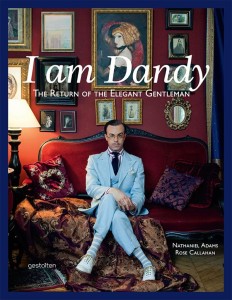
It’s a large and lavish hardback comprising profiles of about sixty gentlemen who dress in an individual and elegant way. The book combines full colour photographs by Rose Callahan with text by Nathaniel ‘Natty’ Adams, based on his interviews with the dandies. It is the sort of volume that was once called a coffee table book. I suppose now it is better described as a latte plinth offline HD tablet.
Given the event is about dandyism, I decide to don Sebastian Horsley’s old suit once again, the silver velvet John Pearse 3-piece, now altered to fit me a bit better. Keen to represent my own style as much as the late Mr Horsley’s, I leave out his wing-collared Turnbull & Asser shirt in favour of one of my own cheap small-collared supermarket shirts, and add my simple white pocket square handkerchief, seahorse brooch and cufflinks, along with my battered Gucci loafers. Belatedly I forgot I own a Cad & The Dandy tailored shirt of my own – never mind.
Some years ago a similar photography book on modern dandies came out. It included the Dexys singer Kevin Rowland and Sebastian Horsley. I remember (shamefully) whining to Mr Horsley that I wasn’t included. ‘Oh, you’ll be in the next one,’ he said. He was quite right. So that’s another reason to wear his suit to the launch. A Double Dandy representation.
It’s a rainy evening. A doorman tips his top hat to me as I enter. The shop is an unexpectedly large and high-ceilinged space, with a balcony floor that functions as a museum of Gieves & Hawkes’s history. Glass cases display military tunics, centuries old. Among the many suits on rails and manniquins, hat boxes, chests of drawers and cutting tables there is a jazz band playing, while at the other end of the shop a stage has been set up to make announcements. It has a screen as a backdrop which projects a selection of photos from the book. Waiters offer free champagne, then hover around and refill your glass when it runs low. After the champagne runs out, I move onto lychee martinis. One of the great things about book events is that they’re over by 8pm, so one can get drunk and be in bed by ten, to make an early start on recovering. Book launches lend themselves to efficient hangover management.
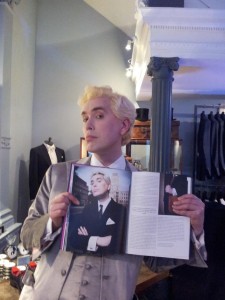
[pic by Suzi Livingstone]
I say hello to people I know: Suzi L, Minna M, Rose and Natty, and chat with some of the other dandies in the book who are at the event: Robin Dutt, Ray Frensham, Tony Sylvester (the gentleman from the Quietus article), Barima Nyantekyi, Michael ‘Atters’ Attree, Gustav Temple. There’s also the teenage dandy Zack MacLeod Pinsent. It will be interesting to see if young Mr P keeps up his look into his twenties and thirties; many people his age are still working out who they are.
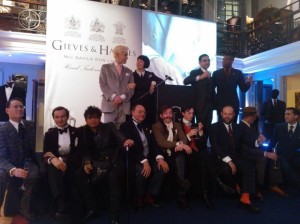
[pic by Kira of Scarlet Fever Footwear.]
The photographer Kahlil Musa has a portrait studio set up in the changing room area. Here’s the shots he took of me on the night.
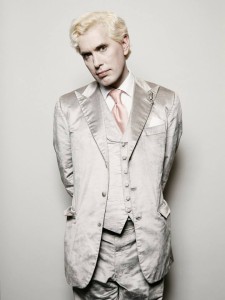
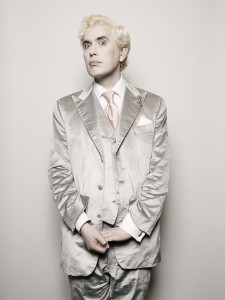
[Pics by Kahlil Musa, taken from the Gieves & Hawkes Facebook and Pinterest pages]
Given that dandies are like cats: essentially aloof, wary and self-contained (at least, that’s one way I define dandyism), it’s quite a coup to gather so many of them in the same room, let alone get them to agree to be in the same book. There are also inevitably going to be opinions over who should have been in the book but wasn’t, and who was included but isn’t a ‘proper’ dandy. But at this event no fights break out, and everyone seems friendly and fun. Mr Atters is particularly entertaining; I’m impressed by his choice of lapel brooch: a small stuffed bat.
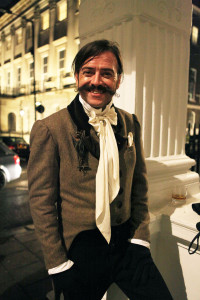
[pic by Kelly René Miller from the Stylesight blog]
Along with the other dandies present, I sign a couple of copies of the book for Rose & Natty, for their own collection. Specifically, I sign the photo of me in a chalk white suit – the whiteness lending itself to the purpose.
It’s a shame the American dandies in the book couldn’t be there, as it’d be nice to see the ones I’m acquainted with such as Fyodor Pavlov (whose wedding I attended) and Cator Sparks (who showed me round New York). I’d also like to meet Lord Breaulove Swells Whimsy and, most of all, Gay Talese. At 81 years of age, Mr Talese has maintained an almost OCD approach to dandyism: one of Ms Callahan’s most striking photos shows his wall of hats, all carefully wrapped in clear dust covers and labelled underneath like hunting trophies. Which in a way is what they are. He’s also the only dandy in the book to have his own words published as a Penguin Modern Classic.
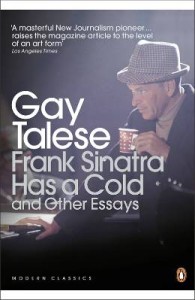
I keep meeting British book lovers who haven’t heard of Gay Talese (pronounced ‘Ta-leez’), or his classic magazine article ‘Frank Sinatra Has A Cold’. I suspect this is because, unlike his New Journalism colleagues Tom Wolfe, Hunter S Thompson, and Truman Capote, he never wrote actual fiction, not even heavily autobiographical fiction.
The New Journalism gang believed – though perhaps not officially – that writers should put an effort into styling their appearance as well as their prose. Gay Talese is definitely a dandy. Wolfe has his white suits; Capote and Thompson each maintained a strong look. Whenever I’m in a bookshop and have to choose between two equally attractive books (in terms of content), I have to find a reason to choose one over another. So I look at the author photo and judge them by the choice of clothes they make. Double denim novelists, be warned.
Links with more photos & info on the I Am Dandy event:
Book ordering details from the publisher, Gestalten
Gieves & Hawkes blog
Rose Callahan’s Dandy Portraits blog
Stylesight
Mode Parade
Dandyism.net
Gay Talese’s 1966 article ‘Frank Sinatra Has A Cold’ can be read for free at the Esquire website. But the more stylish option is to buy the Penguin Modern Classics edition. And be seen reading it in public.
* * *
Friday 20th September. Â Rushing to cross the road, I manage to pull a muscle in my back, and walking for the next two days becomes painful. I seem to be prone to such injuries, having consigned myself to a weekend of limping a month or so ago after doing something similar to my ankle.
In my case, the degree of overexertion is risible; it is not caused by any manly overdoing it on the rugby field or in the gym, but just by a sudden everyday movement after a period of staying still. The ankle pain was the result of waking up one morning, realising I was late for a train, then putting my foot out onto the floor too quickly. That was enough. An anxious and tense thing by nature, I am not built for making sudden movements full stop, even for flight rather than fight. I would make the world’s worst spider.
Saturday 21st September. To the Adam Street club off The Strand, to DJ for the Last Tuesday Society once again. Before I start there is a talk on the I Am Dandy book by Rose Callahan and Natty Adams. I ask them if they found some crucial difference between American and European dandies.
‘Firstly,’ says Mr Adams, ‘it’s only ever Europeans who ask that question about Americans being different. If there is a difference it’s that American dandies tend to look to the 1920s Jazz Age styles, while Europeans favour the Victorian age.’ He cites the top hat as something that Americans particularly tend to avoid.
Evidence of a post-Fifty Shades of Grey era. Although the club night is not a fetish one, in a corner of the room in which I am DJ-ing is an apparatus for being strapped to and whipped, and tonight there is a black-clad gentlemen hired to do just that. I think at first that the people being whipped are also hired by the promoters, in the spirit of providing an interesting ambience. But it transpires they are partygoers:Â it’s an option included in their ticket. Every song I play while the whipping and spanking goes on takes on immediate innuendo, though accidentally. ‘I Want To Be Happy’, ‘Get Happy’, ‘In The Mood’ and especially: ‘Blue Moon’.
Tags:
book launches,
Dandyism,
gay talese,
gieves & hawkes,
i am dandy,
natty adams,
rose callahan,
Sebastian Horsley
Sebastian’s Hoarding
I am appearing in two books by other people, both due out this autumn.
One is I am Dandy: The Return of the Elegant Gentleman. Published by Gestalten (Link here). Portraits of modern dandies, of which I am one, as taken by Rose Callahan. Nathaniel Adams provides a text. I’ve not seen a copy yet, but the cover looks like this:
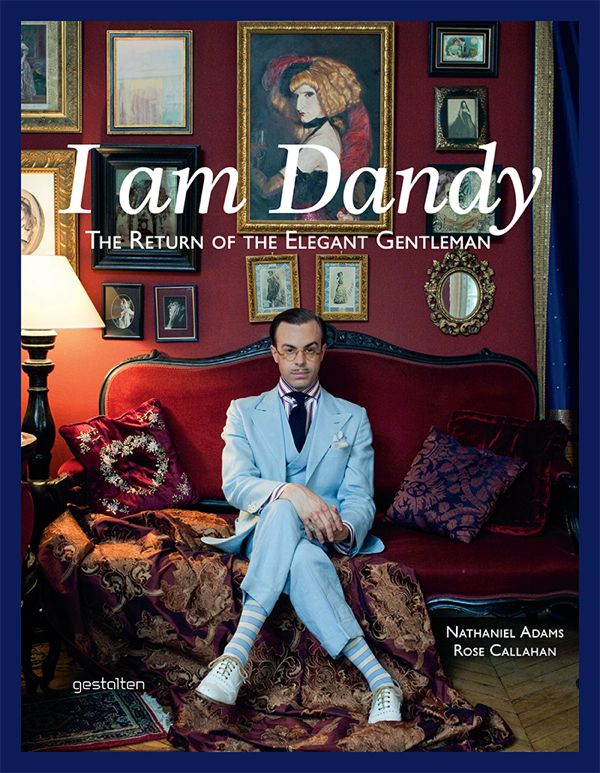
The other is A London Year: 365 Days of City Life in Diaries, Journals and Letters, compiled by Travis Elborough and Nick Rennison. Published by Frances Lincoln (link here). My online diary is in there, along with the diaries of Samuel Pepys, Derek Jarman, and Alan Bennett.

In both cases, I’m enormously flattered to be included. It’s heartening to feel of abiding use in two fields I feel at home with: dandyism and diary writing. It’s also a reminder that I need to do more with both.
The third field I’ve felt of use to lately is academia. In mid-July, I got the results for the 2nd year of the BA in English which I’m doing at Birkbeck. I was very, very pleased to receive a First in each of the three modules that made up the year, despite my misgivings about the exams and suffering what I suppose must be Difficult Second College Year Syndrome. The novelty of being a mature student had worn off, the work became harder, and I was constantly faced with wondering if I should stick with the degree at all.
So the results remind me that despite the lack of paid work coming my way at present, I know I can at least produce written work in a particular style (in this case, academia) and deliver it on time, and that it’s objectively regarded as Of Worth. So I have that to cling to, for now. Having no money beyond the basics is always going to be frustrating,  but it’s really the sum of my problems at present, and it could be much worse.  I hope something turns up. I’ve no idea what, though.
In the meantime, I’m getting on with studying the texts for the next term.
***
Reading about rare words, I come across one which seems to sum things up for me: ‘aestivation’. It means the act of passing the summer. More particularly – when referring to animals – it means spending the summer in a state of inactivity; the summer equivalent of hibernation.  In Alan Hollinghurst’s The Spell it is used to describe a character’s sex drive: ‘it seemed to have gone into a monkish kind of aestivation.’
***
Saturday August 24th. A rainy day in Soho. Parts of the district are still being clawed out of the earth by the diggers, as part of the endless Crossrail development. Some of the building site hoardings are used as a kind of outdoor museum, laminated boards telling the history of Soho. I find the section about The Colony Room, tucked away in the northwest corner of Soho Square, by the junction with Soho Street. I brave the rain and take a few photos. The images on the hoarding are mainly taken from Sophie Parkin’s book on the Colony (link:Â http://www.thecolonyroom.com/).
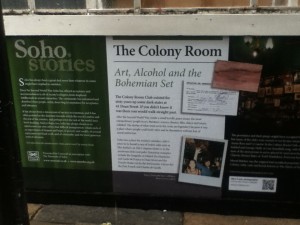
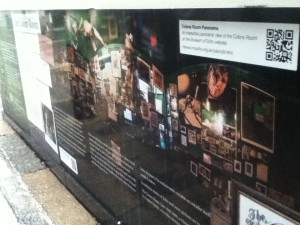 Â
 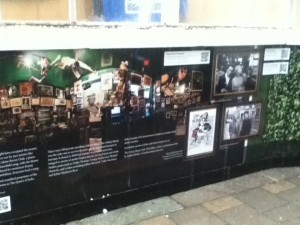
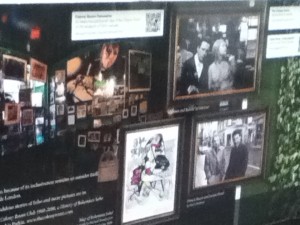
There’s a portrait of Sebastian Horsley, with Babette Kulik:
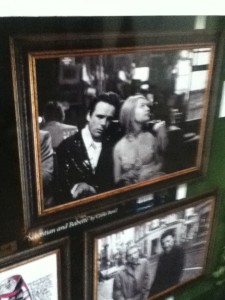
Taylor Parkes comments: ‘That’s London these days, isn’t it? Let all this stuff die, then set up a bloody museum in the street about how great it all used to be.’
Sebastian H certainly shared this sentiment about the Crossrail works affecting Soho, just before he died. So it’s quite amusing to see him decorating the building site like this – I like to see it as a defiant reclamation of territory.
Later, I walk around the newly expanded King’s Cross station. A regular sight there is a crowd of tourists queuing up to have their photograph taken with the half-embedded luggage trolley beneath the obliging sign for ‘Platform 9 and 3/4’.  For eight pounds, a couple of enthusiastic staffers from the nearby Harry Potter souvenir shop provide each tourist with extra props – a Hogwarts scarf and an owl cage – and take the photo for them. ‘One! Two! Three! Jump! Awesome!’ And again, for the next person in the queue.
Tags:
birkbeck,
London,
Sebastian Horsley,
soho
Sebastian’s Button
Saturday 16 June. I DJ at the Last Tuesday Society shop at 11 Mare Street. The event is to mark the opening of an exhibition of Sebastian Horsley’s art, though there’s also quite a few exhibits which count as posthumous relics of his life, as in the medieval saint sense. One is his Filofax appointments diary, open at the week in which he died in 2010, now mounted in a box as if it were just as much a considered artwork as his huge paintings of crosses and sunflowers. It is art as souvenirs of a life. Which is one way of describing all art.
I wear his silver velvet suit, the one that his girlfriend Rachel Garley picked out for me. Rachel is there herself, as is Ms Manko and Jason Atomic – people I knew from my Kash Point days. A few people say hello who read my blog, which is always nice. Particularly when they buy me drinks. Someone says the suit makes me look like… (wait for it)…  ‘David Bowie during the Serious Moonlight tour’.
***
Monday 18 June: Â one of the buttons on The Sebastian Shirt has broken, its plastic clasp split. So today I look for a replacement. In his book (and in the Tim Fountain stage play), Sebastian quips about needing covered buttons because ‘there’s nothing so rude as an uncovered button’.
It is only now that I realise just what the phrase ‘covered button’ truly means. It means that not only has the shirt been handmade, but the buttons have been handmade too, covered with the same material as the shirt. I don’t think I can cut a piece off the shirt to do this – that feels rather wrong. It is, after all, made by Turnball and Asser, shirtmakers to The Prince Of Wales.
So, seeking a replacement, I take the broken button to John Lewis. They’re not much use, as they deal only in the uncovered sort. Â Then to The Button Queen shop in Marylebone Lane. They are very nice but they send me away to hunt down a ribbon of matching material first. This feels too much like hard work. I like errands to be self-contained and finite, not to give birth to further errands with no end in sight.
Taylors Buttons in Cleveland Street saves the day. The business has been going for over 100 years, and the lady who runs it, Maureen Rose, has herself owned the shop for 60 years.
Ms Rose suspects correctly that I want the problem solved with zero further effort on my part. She finds some white material in a bag and makes me a replacement button on the spot. It takes her about two minutes, and she charges me £1.
News story about Maureen Rose here.
***
Evening: to the Wheatsheaf pub in Fitzrovia, for a book event hosted by the Sohemian Society. Cathi Unsworth talks to Laura Del-Rivo about her wonderful 1961 novel of bohemian Soho life, The Furnished Room. Ms Del-Rivo describes the sense of needing to find other bohemians in her youth vividly – the sheer relief at discovering the shared houses and bars where there were people like her. These days all one needs to find people as strange as oneself is just to go on the Internet; back then, you had to move house.
Afterwards I chat with Travis Elborough in the alleyway outside. Suddenly a taxi drives through – Ms Del-Rivo and the rest of us have to stand aside – and out gets Ben Goldacre, who is a kind of Cult Author of today. He happens to be on his way to something nearby, but stops for a quick chat. It’s all Very London – different worlds of writers, different interests, but always colliding.
Another Very London moment is when I arrive before the talk and join Travis as he chats to a blond woman. I’d assumed she was some friend of his. In fact he’d arrived by himself, and has known her about five minutes; it’s just that the atmosphere is of such unabashed and open friendliness, the kind people might associate more with New York. Halfway through the event, she is sitting with us when, without a word, she gets up and leaves and is never seen again.
A line from The Furnished Room (paraphrasing), which seems Very London, 50s and now:
‘But what exactly are you looking for?’
‘Something to look for.’
***
The Furnished Room has just been republished by Five Leaves, available here. Highly recommended.
I love this photo of Laura Del-Rivo, taken by Ida Kar in the early 60s:

Tags:
ben goldacre,
last tuesday society,
laura del rivo,
Sebastian Horsley,
travis elborough
Instant Myths
Into my last week of revision. One of the many rewarding things about studying English literature at Birkbeck is that the lecturers have often written introductions to the books. Today I was going over my lecture notes on Stevenson’s Jekyll and Hyde – the lecturer being Roger Luckhurst – and re-read the Oxford Classics edition of the text, which has an introduction and annotations by him too.
Today: I look at the London Library’s 1886 edition of Jekyll & Hyde, available for members to borrow. The book was first published in January of that year, but the library’s copy is not a first edition. Or even a second. Jekyll & Hyde was such a bestseller – such an instant myth – that the book hit its sixth edition within a few months. How strange to think its original appeal was as a crime mystery as much as a gothic horror: the revelation that Dr Jekyll IS Mr Hyde is the twist ending. Now, of course, the twist is more famous than the original story. But the Stevenson text always feels fresh, however much one re-reads it. There’s the business with the two doors, the flat in Soho, and the innuendo over what exactly it is that Hyde gets up to (as played on by Wilde in Dorian Gray). But what impresses most of all is the sheer innovation of the text, blending genres, creating levels of disorientation, anticipating Modernism and psychoanalysis, inspiring The Hulk; all this, and Stevenson carries it off in a mere sixty pages.
***
The other day: I bump into Darren Beach on the tube, who tells me about his new concept music blog One Below Ten. The idea is that every entry is about a pop single that made it to Number Eleven in the British charts; so close yet so far to becoming a proper Top Ten hit (which really matters to those to whom it matters). The first subject is ‘Michael Caine’ by Madness, which I’m rather fond of. Still odd to think that the very mannered and gentle lead vocals are not by Suggs but by Chas Smash, the same man who shouted ‘Hey you – don’t watch that, watch this!’ on ‘One Step Beyond’, in rather a different style. But then, as Mr Beach says, Madness were a different band in 1984:
http://onebelowten.wordpress.com/
***
My friend, the charming glam rock god David Ryder-Prangley, has just moved in next door. By coincidence, I’d been listening to a track by KISS, of whom I’m not a massive fan, but I know that Mr DRP is very much an admirer. It’s because I’m preparing a DJ set for an event to celebrate Sebastian Horsley, and the song – ‘C’mon And Love Me (Alive! version)’ is in the late Mr H’s list of his favourites. Like a lot of those sort of bands, I may not be keen on the music, but I fully approve of the glamour.
Tags:
college,
david ryder-prangley,
jekyll and hyde,
madness,
Sebastian Horsley























